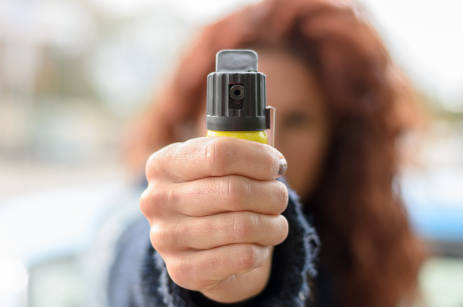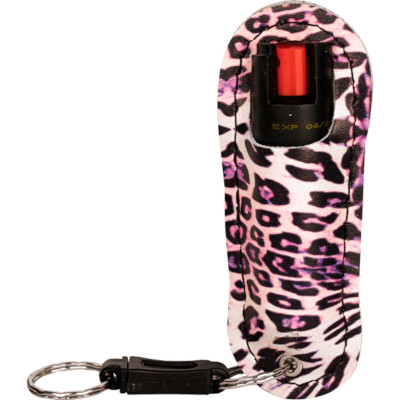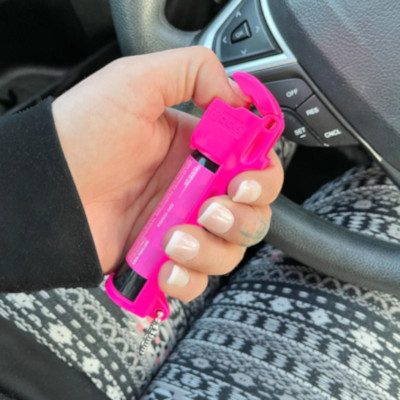Pepper Spray vs Mace

When it comes to self-defense sprays, many people wonder about the difference between pepper spray and Mace. While these terms are often used interchangeably, they are not the same.
Understanding the differences between these self-defense tools can help you choose the right one for your personal safety needs. In this guide, we’ll break down how each works, their effectiveness, and legal considerations so you can make an informed decision.
What Is Pepper Spray?
Pepper spray is a highly effective self-defense tool made from oleoresin capsicum (OC), an active ingredient derived from chili peppers. This compound is responsible for the intense burning sensation, inflammation, and temporary blindness that occurs when sprayed into an attacker’s face.
Effects of Pepper Spray
- Immediate reaction: Causes intense burning, pain, and temporary vision loss.
- Inflammatory agent: Affects the eyes, nose, throat, and skin.
- Duration: Effects typically last 30 to 45 minutes.
- Legal availability: Pepper spray is legal in all 50 states, although some states have restrictions on size and strength.
Pros & Cons of Pepper Spray
✅ Highly effective against attackers, including those under the influence of drugs or alcohol.
✅ Legal in all 50 states, though some states have regulations.
✅ Easy to carry and use, available in spray cans, gel, and foam.
❌ Can be affected by wind (blowback risk when using a spray).
❌ Requires some aiming skills for maximum effectiveness.
What Is Mace?
Many people believe that Mace is just another name for pepper spray, but it’s actually a brand name of self-defense products.
The Original Mace (Tear Gas)
The original Mace® formula, introduced in the 1960s, contained phenacyl chloride (CN gas), a type of tear gas. While it caused irritation and temporary discomfort, it was found to be ineffective against individuals under the influence of drugs or alcohol.
Due to safety concerns and legal restrictions, traditional tear gas Mace is no longer widely used.
Modern Mace Products
Today, Mace® Brand produces a variety of self-defense sprays, including pepper spray formulas similar to other brands. Some of their products also combine tear gas and UV dye, offering an added identification feature.
Pros & Cons of Mace
✅ Brand recognition – Mace is a trusted self-defense brand.
✅ Some Mace products combine pepper spray and tear gas for extra stopping power.
✅ Available in different formulas, including gel and foam for better accuracy.
❌ Some older CN gas formulations are ineffective against intoxicated individuals.
❌ Certain Mace products have legal restrictions in states like Washington, Wisconsin, and Hawaii.
Pepper Spray vs. Mace: The Key Differences
| Feature | Pepper Spray | Mace (Original Tear Gas Formula) |
|---|---|---|
| Active Ingredient | Oleoresin Capsicum (OC) | Phenacyl Chloride (CN Tear Gas) |
| Effect | Causes intense burning, temporary blindness, coughing, and inflammation | Causes mild irritation, watery eyes, and disorientation |
| Effectiveness | Works on all individuals, including those under the influence of drugs or alcohol | Less effective against individuals under the influence |
| Duration | 30–45 minutes | 5–15 minutes |
| Legality | Legal in all 50 states (some restrictions apply) | Illegal in certain states due to tear gas regulations |
| Recommended for Self-Defense? | ✅ Yes! Most effective personal defense spray | ❌ No, unless using a modern Mace brand pepper spray |
♦ Note: All Mace Brand Pepper Sprays sold on TBOTECH are modern sprays that are very effective.
Which One Should You Choose?
If you’re looking for a reliable self-defense spray, pepper spray is the best option.
✅ Pepper spray is more effective – it incapacitates attackers quickly, allowing you to escape.
✅ It’s legal in all 50 states (though some states regulate size and concentration).
✅ Modern Mace products with OC pepper spray are just as effective as other brands.
♦ Tip: If purchasing Mace® brand spray, ensure it contains oleoresin capsicum (OC) for maximum stopping power.
How to Use Pepper Spray or Mace Effectively
To ensure maximum protection, follow these self-defense spray tips:
1️⃣ Keep it accessible – Store in your pocket, purse, or on a keychain for quick deployment.
2️⃣ Aim for the face – Target the eyes and nose for maximum impact.
3️⃣ Use short bursts – A 1–2 second spray is usually enough to disable an attacker.
4️⃣ Move away quickly – Once sprayed, use the opportunity to escape and seek help.
5️⃣ Practice using it – Get familiar with your spray’s trigger mechanism to avoid fumbling in an emergency.
♦ Caution: Always check local laws before carrying pepper spray or Mace to ensure compliance with regulations.
Final Verdict: Pepper Spray Wins
When comparing pepper spray vs. Mace, pepper spray is the superior choice for personal safety and self-defense.
✔️ Works on all attackers, including those under the influence.
✔️ Provides immediate, intense pain and temporary incapacitation.
✔️ Legal in all 50 states (with minor restrictions).
If you’re looking for the best self-defense spray, shop our collection of high-quality pepper sprays today and take control of your personal safety.


